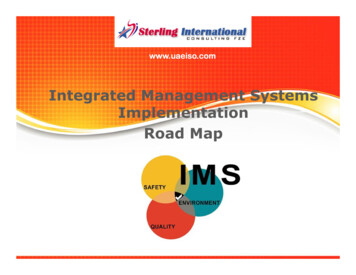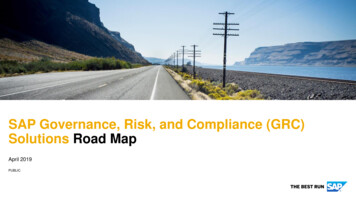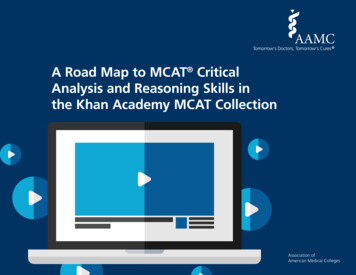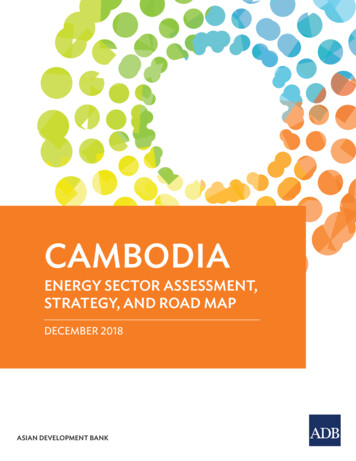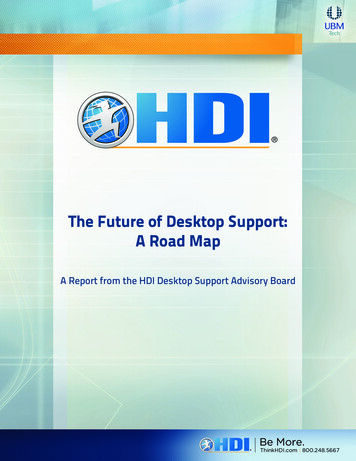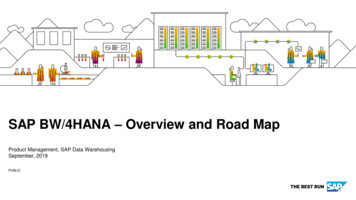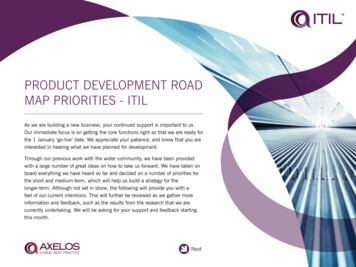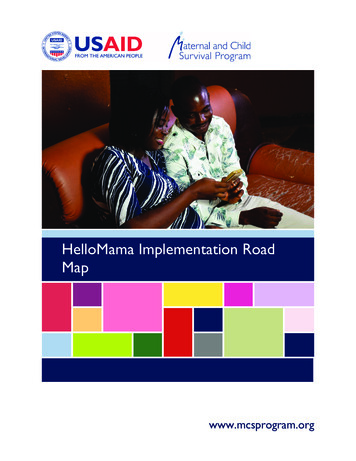
Transcription
USAIDFROM THE AMERICAN PEOPLE Aaternal and Child/ Survival ProgramHelloMama Implementation RoadMapwww.mcsprogram.org
Document Contributors:Erik Harding, PraekeltChichi Aigbe, PraekeltChima Chinda, PraekeltEmeka Mba, ConsultantPaul Tuthill, JhpiegoEmmanuel Atuma, JhpiegoJoy Hadiza Marcus, JhpiegoJoseph Enne, JhpiegoOluwatoyin Adewole, JhpiegoGeoff Prall, JhpiegoAlishea Galvin, JhpiegoYemisi Ojo, Pathfinder InternationalAyomipo Edinger, Pathfinder InternationalIrene Pam- Pathfinder InternationalMCSP is a global USAID initiative to introduce and support high-impact health interventions in 25 prioritycountries to help prevent child and maternal deaths. MCSP supports programming in maternal, newborn, andchild health, immunization, family planning and reproductive health, nutrition, health systems strengthening,water/sanitation/hygiene, malaria, prevention of mother-to-child transmission of HIV, and pediatric HIVcare and treatment. MCSP will tackle these issues through approaches that also focus on household andcommunity mobilization, gender integration, and digital health, among others.This report is made possible by the generous support of the American people through the United StatesAgency for International Development (USAID) under the terms of the Cooperative AgreementAID-OAA-A-14-00028. The contents are the responsibility of the Maternal and Child Survival Program anddo not necessarily reflect the views of USAID or the United States Government.Cover photo credit: Karen Kasmauski/MCSPMarch 2019
Table of ContentsAbbreviations. ivAcknowledgments. vIntroduction . 1Program Description . 1Introduction to the Road Map. 1Management Structure . 2Content Management . 3Training, Support, and Engagement. 4Promotion Support . 6Technology Management . 8Monitoring Evaluation and Research.17Annex I. Monitoring, Evaluation, and Research Indicators . 20Annex II. Conceptual Overview and Documentation . 22HelloMama Stack . 22Postgres. 24Puppet. 24Infrastructure Overview .25Hosting Overview. 27Annex III. Partnerships, Roles, and Responsibilities . 30Annex IV. HelloMama Brief . 31HelloMama Implementation Road Mapiii
AbbreviationsANCAPIantenatal careapplication programming interfaceCHEWcommunity health extension workerDHISDistrict Health Information SystemFGDfocus group discussionFMOHFederal Ministry of HealthGONGovernment of NigeriaHCWHealth care workerHTTPHypertext Transfer ProtocolICTInformation and communication technologyIVRinteractive voice responseMAMAMobile Alliance for Maternal ActionMCSPMaternal and Child Survival ProgramMNOmobile network operatorMNCHmaternal, newborn, and child healthOBDOutbound dialOSOperating SystemSMOHState Ministry of HealthSMGLSaving Mothers, Giving LifeSMSshort message serviceSOMLSaving One Million LivesSURE-PSubsidy Reinvestment and Empowerment ProgramUSAIDUS Agency for International DevelopmentUSSDVMUnstructured supplementary service datavirtual machineivHelloMama Implementation Road Map
AcknowledgmentsThe Nigerian National Health Information and Communication Technology (ICT) Strategic Frameworkpositions health ICT within the current context of the health system, addressing universal health coverage,one of the main priorities of the Government of Nigeria (GON). 1The emergence and rapid proliferation of mobile phones in sub-Saharan Africa presents an opportunity toaccelerate progress toward attaining national health goals, especially for maternal, newborn, and child health.Therefore, the opportunity to design and implement a medium- to large-scale digital health messagingintervention for pregnant women and new mothers was anticipated and well received by the GON.In 2015, the Mobile Alliance for Maternal Action in Nigeria, with funding support from USAID and Johnson& Johnson, was launched by the GON and partners as a 3-year program (October 2015–September 2018)and branded as HelloMama for implementation in Cross River (South South) and Ebonyi (South East) statesin Nigeria. The tasks of meeting the high expectations and anticipating what many expected to be a gamechanger in the maternal and child health landscape were daunting, especially as the project ventured into anuncharted terrain, navigating the nation’s unproven ICT infrastructure.The team learned many lessons when implementing this program in Nigeria, including about partnerships,role clarification, technology appropriateness and adoption, and the diverse sociocultural context that affectspositive health-seeking behaviors for maternal and child health outcomes.The federal and supported state ministries of health, in collaboration with the HelloMama consortium todevelop this document to serve as a road map for ongoing and future digital health implementation inNigeria, drawing from lessons and experiences gathered during program implementation.Emmanuel Atuma, HelloMama project director, would like to extend sincere appreciation to institutions,including the federal and state ministries of health and of communication/ICT, development andimplementing partners, and those that participated in and contributed to program implementation anddevelopment of this document. The team especially commend the support and cooperation of the programimplementing partners: Jhpiego, Pathfinder International, Praekelt, the family health and ICT departments inthe Federal Ministry of Health, and other key stakeholders, such as health care workers in the over 142facilities in Ebonyi and Cross River states, and over 64,000 subscribers (pregnant women, new mothers, andtheir families), for whom this service was designed. HelloMama consortium, the team want to thank otheractive players within the Nigeria digital health ecosystem, whom we learned from and shared with.Special appreciation goes to Dr. Isaac F. Adewole, the Honorable Minister of Health; Dr. Inyang Asibong,honorable commissioner for health in Cross River State; Dr. Daniel Umezurike, honorable commissioner forhealth in Ebonyi State; Dr. Oniyire Adetiloye, country director for Jhpiego Nigeria; Dr. Farouk Jega, countrydirector for Pathfinder International; and Debbie Rogers, managing director of Praekelt, for providingleadership and unflinching commitment throughout the entire program implementation, making thedevelopment of this national road map for digital health implementation in Nigeria a reality.1Federal Republic of Nigeria. 2016. National Health ICT Strategic Framework 2015–2020. Abuja, Nigeria: Federal Republic of Nigeria; 12.HelloMama Implementation Road Mapv
viHelloMama Implementation Road Map
IntroductionProgram DescriptionThe Mobile Alliance for Maternal Action (MAMA), a global consortium with public-private funding,delivered vital health information during its 5 years of operations (2010–2015) to pregnant women, newmothers, and their families through mobile phones with messages specifically designed for behavior change.Through an age- and stage-based model, the messages corresponded to what a woman was experiencing inher pregnancy or in her child’s development, creating a trusting relationship between the recipient, or enduser, and the MAMA service. MAMA directly focused on and supported countries where high maternal andnewborn mortality rates intersect with an increasing proliferation of mobile phones—Bangladesh, India, andSouth Africa.In 2015, MAMA Nigeria was launched by the Government of Nigeria (GON) and other partners as a 3-yearprogram (October 2015–September 2018) and branded as HelloMama for implementation in Cross River(South South) and Ebonyi (South East) states in Nigeria. These states had US Agency for InternationalDevelopment (USAID) funding support for maternal and child health interventions through Saving Mothers,Giving Life (SMGL) and the Maternal and Child Survival Program (MCSP).The HelloMama program operated in Nigeria with the goal “to improve the health outcomes for pregnantwomen, newborns, children, and families in Nigeria through age- and stage-based mobile messaging thatcomplements the efforts of frontline health workers.” It had two key specific objectives:1. Establish an operational, nationally scalable platform for adequate coverage that makes age- and stage-based mobile messages available to the target population and links to existing health information systems.2. Complement supply-side maternal, newborn, and child health (MNCH) interventions by improvingknowledge and adoption of healthy and safe MNCH practices.The program was locally led, planned for scale-up, and complemented the national health care system by aligningwith health priorities, policies, and systems. At inception, the program started with seven core partners: theSubsidy Reinvestment and Empowerment Program (SURE-P), Pathfinder International, the Praekelt Foundation,Johnson & Johnson, USAID, MAMA global, and the Federal Ministry of Health (FMOH).However, in November 2015, the GON dissolved SURE-P. In December 2015, the MAMA global secretariatwas dissolved. Though USAID Nigeria had envisioned that Ebonyi and Kogi states (supported by MCSP)would be included in the HelloMama implementation phase, MCSP did not play a role at inception until thesecond year, when the overall coordination of HelloMama shifted from SURE-P to MCSP via in-countryimplementing partner Jhpiego, with Pathfinder and the Praekelt Foundation remaining as subgrantees, whileJohnson & Johnson and USAID continued as funding agencies.Introduction to the Road MapThis document leverages contemporary technology to strengthen health systems and attempts to chroniclethe technical approaches, management structures, and levels of stakeholder engagement in the initializationand implementation of HelloMama in Nigeria. It serves as a guideline on the basic intricacies of setting upsimilar platforms in Nigeria and can be used by current and future implementers of digital messaging servicesfor maternal and child health in sub-Saharan Africa.The road map has two key objectives:1. Provide clarity on resource requirements for executing a similar digital health messaging platform inNigeria.2. Share methodology and documents that will drive the future deployment of a successful digital healthplatform built on HelloMama’s approaches and lessons learned.HelloMama Implementation Road Map1
Management StructureProgramsUSAID designed HelloMama’s program management structure to be lean and streamlined. At inception, theHelloMama program had only three full-time staff recruited by MCSP: a project director, senior programmanager, and program assistant. The program aimed to mirror the structure of the relevant maternal andchild health departments in the FMOH and state ministries of health (SMOHs) by leveraging core teamswithin technical assistance organizations and teams within the FMOH (family health and, later, informationand communication technology [ICT] departments) at the national level. At state levels, it leveragedimplementing partners’ state teams that had counterparts within the SMOH, public health department, andother relevant departments that oversee safe motherhood and reproductive health.After the first year of operation, it became clear that HelloMama required more level of effort from partnerorganizations and other personnel support, especially as state-level implementation required frequentengagement of health care workers (HCWs) to promote adoption and troubleshooting on the technologyplatform. Also, the data and monitoring, through dashboard and facility data recon
Map www.mcsprogram.org . Document Contributors: Erik Harding, Praekelt Chichi Aigbe, Praekelt Chima Chinda, Praekelt Emeka Mba, Consultant Paul Tuthill, Jhpiego Emmanuel Atuma, Jhpiego Joy Hadiza Marcus, Jhpiego Joseph Enne, Jhpiego Oluwatoyin Adewole, Jhpiego Geoff Prall, Jhpiego Alishea Galvin, Jhpiego Yemisi Ojo, Pathfinder International Ayomipo Edinger, Pathfinder International Irene
